|
Ampeer Paper Subscriber Reminder
When subscribing to or renewing the paper version of the Ampeer, please make the check payable to Ken Myers. We do not have a DBA for the Ampeer or EFO. Thanks, Ken
Setting Up and Syncing Twins
From Bob Seeger jseeger34@sbcglobal.net
Preface:
Bob had written to me asking how to set up a twin B-25 so that the motors would sync. He noted that he was using a Futaba transmitter and wasn't having any success in getting information from Futaba on how to do it. I told him that I'd ask Keith, as I was seeing him soon. Keith told me that he doesn't worry about syncing his twins, and I relayed the information to Bob. On the same day that I sent Bob an email with Keith's answer; I received the following interesting information from Bob. Thanks Bob!
Hi Ken,
Here are two links that should help anyone who wants to setup a twin. From Futaba I used the 3-7 mix, not the 7-8. One thing I changed is the "trim off" instead of "trim on". That way, you can use the trim on one motor to tune into the other motor. Seems to work fine.
Hopes this helps someone.
Bob Seeger
www.castlecreations.com/CastleScribeCE-03-Mar2006.pdf
Here is a link that explains how to set up dual engines/motors.
www.futaba-rc.com/faq/faq-8u-q186.html
Return to "What's In This Issue"
A Really Good Weather Site for US!
From Plenny Bates plennyb@mchsi.com
Below is a web site intended for skydivers, hang gliders etc. The data is from the national weather service but they put it into a very user-friendly format.
There is a lot of data there and it is easy to use. Our local newspaper weather never has the wind for more than the current day.
Needless to say the accuracy go down as the time goes out. I also like the rain chance in %.
If you want to change location, which involves changing states first, change the state and hit "go." Then when you ask for cities you will get that state's list. Change the city and hit "go."
M (Willow Run Airport, close to the Mid-Am is in the address below KM)
www.usairnet.com/cgi-bin/launch/code.cgi?Submit=Go&sta=KYIP&state=MI
Return to "What's In This Issue"
How to Get a Constant 12v
From a 3S2P "A123" Pack
From Guy Fawcett via email
Earlier in the year, Guy wrote and asked how to do this. I had to write back that I really didn't know. Ampeer readers are very resourceful! He found out, and here is his very successful solution! KM
Hi Ken,
I don't know if you remember my asking how to get 12 volts out of 3s2p A123 pack but I finally solved the problem and the attached video link shows the result.
www.youtube.com/watch?v=sLYiWZTzWjk
Guy
When you view the link you'll see that he used it to power a sound system in his S.E.5. Here is what he says at the link. This is so "way cool" you've just got to see it! KM
"I recently purchased an SFX5.3 sound module from Model Solutions of Canada and installed it in my 1/6 scale scratch built RAF SE5 (Dennis Byrant Plans) with a 4" speaker. The aircraft uses a 3S2P A123 battery and since I didn't want to fiddle with an additional battery, I purchased a Dimensional Engineering AnyVolt step up/step down dc-to-dc converter. Basically the component takes any voltage from 4.2 to 28V and converts it to any output voltage from 2.5V to 24V and accepts up to a 2 amp current. I used it to dial in a smooth 12 volts from the flight battery for the soundboard and every thing worked extremely well."
Link to the Dimensional Engineering AnyVolt:
www.dimensionengineering.com/AnyVolt.htm
Link to Model Solutions of Canada SFX5.3 sound module
www.modelsolutions.ca/
Return to "What's In This Issue"
The Upcoming 2009 Mid-America Electric Flies
Flyer
Map & Hotel List
Return to "What's In This Issue"
Multiplex Multilock UNI
From Plenny Bates plennyb@mchsi.com
Ken,
In the March Ampeer I noticed Jim Young's latest effort and how he's attached the wing panels. For holding wings on the sailplane people sometimes use a Multiplex product known as the Multilock UNI
A singe connection is composed of socket, which is mounted in the fuselage, a ball on a stick, which is mounted in the wing root. The ball snaps into the socket and thus holds the wing in place. There is only one socket size but three ball sizes for different wing sizes. Also supplied are bushings to hold the ball/stick in the wing root.
A set gives you:
4- sockets
4 - bushings
4- size #1 ball/stick
4- size #2 ball/stick
4-size #3 ball/stick
1-wedge for removing wing.
As you can see a set gives you enough parts to attach four wings (two models). A set only costs $3.00.
The bad news: You cannot get them in the USA. The good news: I have 19 sets and will sell.
Assuming you are using a spar joiner and locator pin one can use large electrical connectors (the pins are 0.044" square on 0.157" centers) from DigiKey to send power and signal to the servos. I mount the socket in the fuselage and the pin side in the wing. It is important to make the locator pin long enough so it is engaged before the electrical pins start to engage the socket. When the wing is removed from the fuselage I put a spring loaded dummy spar joiner in the wing. This sticks out far enough to protect the electrical pins.
The photos are of the system in use on my DAW 1-26 EPP sloper.
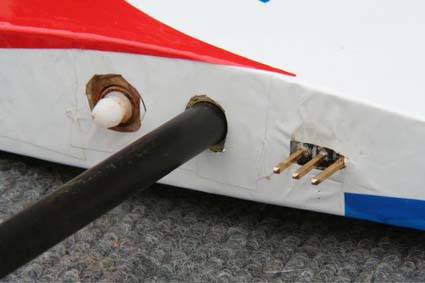
Wing root. The socket for the ball/stick was made from a wood dowel rather than the plastic one supplied.
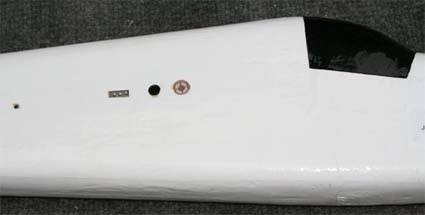
Fuselage side close-up
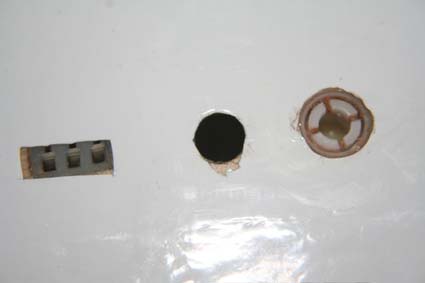
Fuselage side showing the socket for the locator pin aft.
Plenny
Return to "What's In This Issue"
Those "A123" Cells are Really Good!
From Plenny Bates plennyb@mchsi.com
Ken and Keith,
A class issue (Dec. 2008 KM), fantastic red winged old-timer :-) (Plenny's of course. KM)
Seriously, I enjoyed it all. I want to take this opportunity to thank you and Keith for putting us on to the A123's. Others wrote about them but we trust you guys. Right now the M-1s ("A123" 2300mAh KM) are the best things out there for medium to bigger models. Bought 12 DeWalt packs from Keith's suggested vendor, Toolmanonline.com and was given a great price of $120.67/pack postpaid.
On the Super Quaker: Been working on trimming. I reduced the decalage and moved the C.G. back to the point it became unstable. It still had a quick pull out from a shallow dive. Then moved the C.G. forward a bit and it seems to fly well, at least motor off at one speed. For the most part I fly it motor off at one speed and climb at full power with a lot of down. Nine days ago after 4 PM, it was wet, heavy overcast, calm and about 46 F and I put in a 30 min flight. On recharging the battery found I had taken out only 1.5 Ah. Unless you have suggestions I am not going to work on trimming it any more.
Thanks again.
Plenny Bates
Return to "What's In This Issue"
EVERYTHING YOU WANTED TO KNOW ABOUT ELECTRIC POWERED FLIGHT
An e-Book by Ed Anderson
http://www.wattflyer.com/forums/showthread.php?t=31071
Bob Aberle made me aware of this E-Book at the WattFlyer site.
According to the information provided at the above URL, Ed Anderson is "President, Long Island Silent Flyers www.lisf.org, President, Eastern Soaring League www.flyesl.com and Present on the flying field whenever possible."
Who is this book for? In his Preface, Ed notes, "Whether you are a new flyer, a wet fuel pilot, or a glider pilot who wants to add an electric motor to your glider, I hope you find value here. Of course, I will fail to live up to the title as you can't know everything, but I will try to hit the essentials. I am also going to provide an index for your convenience."
He also states that this E-Book is "for new pilots who have no background, if you are starting with an RTF electric airplane and for wet fuel pilots coming into electric."
What will you find in this E-Book?
TABLE OF CONTENTS
Preface
Amps vs Volts vs C
Sizing Power Systems
Props vs. Amps
What is an Electronic Speed Control - Updated 11-2008
The LVC, Low Voltage Cut-off
Who Needs a Wattmeter?
Why Use a Gearbox?
Extended Flight Times and Balance
Battery Basics
Lithium Batteries, Chargers and Balancers
Six Keys to Success for New Pilots
Things to Check on an RTF
Now it's Your Turn!
The Role of the BEC in your ESC
The Mythical Best First Plane
What You Need to Know About Receivers
The AMA Park Pilot Program
What goes on which stick?
WHAT DO THE KV RATINGS ON MOTORS MEAN?
I feel that the information in this e-book should be given to all folks interested in taking up this hobby using electric power. It touches on all of the basic information they need to know to make informed decisions about equipment purchases and gives the them a solid background in the common concepts that apply to the equipment used for producing successful electrically powered planes.
I have posted an edited and annotated version.
If you have occasion to "run into" someone who expresses a serious interest in our hobby, I would recommend that you print out the e-book, carry it with you, and give it to that person. You can also point them to the original Web site and where they can find my edited and annotated version.
Return to "What's In This Issue"
Electronic Speed Controls -
A Clarification or Some Folks Just Don't Get It!
By Ken Myers
From reading the forums online and hearing statements made by my e-flight students, it has become clear to me that many of them do not understand how an electronic speed control (ESC) works. This misunderstanding can have severe consequences to their equipment!
To keep this as simple as possible, I am going to make some statements that are not technically correct. The way an ESC works, how it powers the motor and the motorÕs feedback to the ESC is extremely complicated. Even though this is a very oversimplified explanation, it should save anyone reading this from making a "costly mistake."
An ESC is a switch. It has two states - on or off. It is NOT a valve that controls the flow by opening or closing. It is a very, very, very fast switch.
If the switch is on, all of the power, as determined by the motor's load, is moving from the battery to the motor going through the switch. If the switch is off, none of the power from the battery can get through.
At full throttle the switch is always on, just like turning on the light switch in your house. To change the throttle, which has the effect of varying the RPM, the amount of time that the switch is on is changed. The units of time used in an ESC are extremely short. I cannot even comprehend them! It is beyond my mental grasp.
To keep it simple, let's look at 10 units of time with a word representing one unit of time.
Full on: on-on-on-on-on-on-on-on-on-on
Full off: off-off-off-off-off-off-off-off-off-off
Some partial setting:
on-on-off-off-on-off-on-off-on-on
If a prop is placed on the motor that draws 35 amps at full on, the 35 can replace the word on in the above examples.
Full on: 35-35-35-35-35-35-35-35-35-35
It can be seen that for the ten units of time the average amp draw is 35 for 10 units of time. (350) divided by the time units (10) and the average is 35 over the ten units of time.
There is no reason to do off, of course it is 0.
Some partial setting:
35-35-0-0-35-0-35-0-35-35
In this example there are 6 units of time at 35 (210) and four units of time at 0, but there are still a total of 10 units of time. 210 / 10 = 21 The amp draw averaged 21 amps during those ten time units.
If a power meter is placed between the battery and ESC the meter reads 35 amps for those 10 units of time at full throttle and the motor is "seeing" 35 amps continuously, since the switch is always on. At the partial throttle setting, the meter reads the average amp draw of 21 yet the motor is still "seeing" 35 amps every time the switch switches to the on position. (While technically not true, as I noted, it is close enough for this simple example.) The power meter can only read the average across time. That is true whether the power meter is a handheld unit or an onboard unit. It is only reading the average over a period of time and that period of time is a huge number of switching cycles.
In the example, every time the switch is in the on state, 35 amps is being pulled from the battery, passing through the switch and moving through the commutated windings in the motor.
What does this mean in a practical sense?
It means that you cannot control the current flow through the power system with the throttle position except for full on and full off! It means that the amount of amps that a power meter reads at full throttle, when the switch state is always on, is the amount of current that is flowing whenever the switch state of the ESC is on. It means that any other readings of a power meter at partial throttle settings is averaged over time and has no direct relationship to how many amps are being drawn through the power system when the ESC switch is in the on state.
Bottom line, reducing the throttle or reducing the end point on the throttle channel of the transmitter to put the ESC into a reduced throttle setting does NOT change the amp draw of a given load.
The amp draw of a given prop does change some through the flight regime and it is not that same as the static amp draw. The only way to discern how much it changes in the air would be to use an onboard data recorder and fly the entire flight at full throttle while collecting the data. If the plane were "throttled" back during the data collection, only the average amp draw over time during that portion of the flight would be recorded.
To keep the power system "safe", set it up so that the maximum static amp draw does not exceed the recommended amp draw for the motor, ESC or battery. In practical use, it is even better to set the power system up so that the static amp draw does not exceed 80% of the recommended amp draw of any of components.
Here is an example of a well-balanced system.
Scorpion SII 3014-1220 Max Continuous Current - 46 Amps (80% of 46 = 36.8 amps)
Scorpion Commander V2 45 amp ESC Max Continuous Current - 45 Amps (80% 45 = 36 amps)
It can be seen that with the motor and ESC selected, a prop is needed that will statically load the motor to about 36 amps for the "best", "safe" maximum power.
Expected amp draw with APC 9x7.5E - 37.57 w/3S Li-Poly
(innov8tivedesigns.com/Scorpion/Scorpion%20SII-3014-1220%20Specs.htm)
37.57 expected amp draw * 1.25 (inverse of 0.80) = ~47 amps or 80% of 47 = 37.6 amps
A 47-amp draw was used to compute the appropriate Li-Poly battery sizes.
10C Li-Poly = 4700mAh
15C Li-Poly = 47 amps / 15C = 3.133Ah or 3100mAh
Math is the same on the following except for the divisor.
18C Li-Poly = 2.611Ah or 2611mAh
20C Li-Poly = 2.35Ah or 2350mAh
25C Li-Poly = 1.88Ah or 1880mAh
30C Li-Poly = 1.567Ah or 1567mAh
35C Li-Poly = 1.343Ah or 1343mAh
The pack to choose depends on the desired flight time, acceptable weight of the battery pack for the desired flight characteristics, availability and, of course, the cost. The actual battery mAh would be rounded UP to the nearest real listed mAh with the appropriate C rating.
Using a larger capacity mAh and C rated battery is absolutely acceptable. The numbers above show only the minimum acceptable numbers.
With Li-Poly batteries, the mAh also needs to be de-rated by 80%. That means, that for long life, the common 2100mAh, 2.1Ah, Li-Poly should only have 1680mAh taken out of it before recharging it.
I know that for a 7-minute flight fully aerobatic flight, using a similar set up to this one with "A123" 2300mAh cells, I use consistently about 2050mAh from the battery. For a true comparison, that would make an equivalent Li-Poly about 2050 * 1.25 (inverse of 0.80) = 2563mAh.
For about the same flight time a person could choose to use one of the new Hyperion G3 CX 3S 2500mAh 25C (up to 62.5 amps) packs or even a Hyperion G3 VX 3S 2600mAh 35C (up to 91 amps). As long as the acceptable battery amp draw is over 47 amps for this setup, all will be fine.
Return to "What's In This Issue"
Amps Versus Volts
By Ken Myers
E-flight is all about choices. There are two ways that we can get the input power that we need to fly our models. We can either use high voltage with a relatively low amp draw, or we can use low voltage and a relatively high amp draw.
For the following example I will use a sport plane that has a ready-to-fly (RTF) target weight of about ~80 oz. (5 lb.) and the desired input watts for good performance of ~100 watts in per pound. Therefore we need ~500 watts in for this plane. We will say that it can comfortably accommodate up to a 13-inch diameter prop for ground clearance reasons and that we desire at least seven minutes of flight time. It has approximately 605 sq.in. of wing area.
CWL at 80 oz. = 9.29 (will handle wind well)
Stall speed: ~16 mph
Desired pitch speed 3.5 times the stall speed: 56 mph or greater
Lightest motor weight: 500 watts in / 3g = 167g/5.9 oz.
Heaviest motor weight: 500 watts in / 1.75g = 286g/10 oz.
How can we get there?
3S1P Li-Poly (Applies to 4S "A123" 2300mAh)
500 watts in / 10.5v (approximates the voltage for a typical 3S Li-Poly under load) = 47.6 amps. We will call it 50 amps. That means that the motor, ESC and battery must all be rated for about 50 amps times 1.25 or 62.5 amps for the 80% safety and longevity margin.
Motor: Scorpion SII 3026-890 205g or 7.23 oz., 70 amps continuous - $79.99
Prop: APC 12x8E, ~8200 RPM, Pitch speed 62 mph
Approx. amp draw: 51
ESC: E-flite 60-Amp Pro Switch-Mode BEC Brushless ESC, Wt. 66g/2.33 oz., $84.99
Battery 1: Hyperion G3 CX 3S1P 4000mAh 25C, max amps 100, anticipated flight time based on 80% capacity and amp draw 7.68 minutes, Wt. 306g or 10.8 oz., $77.95
Total wt: 577g or 20.4 oz. Total cost: $242.93
Battery 2: 2 each Hyperion G3 CX 3S 2100mAh 25C in parallel for 4200mAh, max amps 105, anticipated flight time based on 80% capacity and amp draw 8 minutes, Wt. 160g * 2 = 320g/11.3 oz., $42.95 ea./$85.90
Total wt: 591g or 20.8 oz. Total cost: $250.88
Note: The amp draw is really too high to be practical with a 1P "A123" 2300mAh pack. If the pack were 3S2P, or 6 of these cells, it would be quite heavy.
4S1P Li-Poly (Applies to 5S "A123" 2300mAh)
500 watts in / 14v (somewhat typical of 4S Li-Poly under load) = 35.7 amps. Well call it 35 amps. That means that the motor, ESC and battery must all be rated for 35 times 1.25 or about 45 amps for the 80% safety and longevity margin.
Motor: Scorpion SII 3026-710 205g or 7.23 oz., 60 amps continuous (okay) - $79.99
Prop: APC 11x8.5E, ~9200 RPM, Pitch speed 74 mph
Approx. amp draw: 36
ESC: E-flite 60-Amp Pro Switch-Mode BEC Brushless ESC, Wt. 66g/2.33 oz., $84.99
Battery 1: Hyperion G3 CX 4S 3300mAh 25C, max amps 82.5, anticipated flight time based on 80% capacity and amp draw 8.8 minutes, Wt. 363g or 14.2 oz., $85.95
4S Li-Poly
Total wt: 634g or 22.4 oz. Total cost: $250.93
5S "A123" 2300mAh
Battery 2: 5S "A123" 2300mAh pack made from DEWALT pack, max amps 69, anticipated flight time based on actual capacity and amp draw 7 minutes, Wt. 400g or 14.1 oz., ~$65
Total wt: 671g or 23.67 oz. Total cost: $229.98
5S1P Li-Poly
(Applies to 6S "A123" 2300mAh as well)
500 watts in / 17.5v (somewhat typical of 5S Li-Poly under load) = 28.6 amps. WeÕll call it 30 amps. That means that the motor, ESC and battery must all be rated for 30 times 1.25 or about 37.5 amps for the 80% safety and longevity margin.
Motor: TURNIGY AerodriveXp TR 42-60C 500Kv 280g or 9.88 oz., 50 amps, $32.30
Prop: APC 12x8E, ~8100 RPM, Pitch speed 61 mph
ESC: E-flite 40-Amp Pro Switch-Mode BEC Brushless ESC, 62g/2.19 oz., $74.99
Battery: Hyperion G3 CX 5S 2500mAh 25C, max amps 62.5, anticipated flight time based on 80% capacity and amp draw 8 minutes, Wt. 333g or 11.7 oz., $81.95
5S Li-Poly
Total wt: 675g or 23.8 oz. Total cost: $189.24
6S "A123" 2300mah
Battery: 6S made from DEWALT pack, max amps 69, anticipated flight time based on actual usable capacity, 2100mAh, and amp draw 8.4 minutes, Wt. 480g or 16.9 oz., ~$78
Total wt: 822g or 29 oz. Total cost: $184.29
From this example, it can be seen that the lightest system is the most expensive, while the heaviest system is the least expensive. While the lightest system has a slight performance edge, all of the systems will fly the plane well. ItÕs all up to you.
Return to "What's In This Issue"
Important Note About Motor and Propeller Safety
By Ken Myers
An electric motor spinning a propeller is an extremely dangerous tool. Always keep that thought foremost in your mind. Give this tool the same care, caution and respect, as you would when using a circular saw. It is exactly the same type of tool, but without the safety guard required by law on a circular saw! You are choosing to use a very dangerous tool. Use it wisely and with great caution.
The "O" ring that is used to hold some props on some types of prop adapters can break. Prop adapters can "let loose" from the shaft. Shafts can "pull out" of motors. Never allow anyone, including you, in front of or inline with the propeller arc of a spinning propeller. The area in front of a spinning propeller should be clear of objects and walls in case something "lets go" and the prop flies off. Many props will shatter when they hit a hard object sending very sharp projectiles flying everywhere.
Always keep behind the prop. Do not reach over it from the front to hook up a battery, pick up a plane, or for any reason. Remember, it is circular saw with NO blade guard!
Always remove the propeller to check or install the radio system of an electric airplane. The propeller should only be attached to the motor and the battery connected when the plane is going to fly. If the plane is not going to be flown and the battery is to be connected to check or install the radio system, for safety, the propeller MUST be removed. This procedure HAS TO BE FOLLOWED at ALL TIMES! Never ignore it.
There are numerous reports, on the Internet and in the print modeling magazines, of planes zooming off of workbenches, charging across floors and smashing into walls, and propellers lacerating fingers and faces, pets, other people parts and worse. While some of these incidents may sound somewhat humorous if the person wasn't hurt, they were in reality only a split second away from being someone's personal tragedy! ALWAYS remove the prop when the battery is going to be connected and the plane is not going to be flown. No exceptions, ever!
There is NEVER any reason to hold a motor in your hand, especially with the propeller on it, and turn it on, NEVER! Whenever the motor is run, it should be secured to the airframe or a motor test stand. Never run a motor in your hand.
Never lay an electric motor on a work surface without removing all other objects from the work surface first, especially small metal objects like screws and washers that will be attracted to the magnets in the motor. You never want metal objects inside your motor that don't belong there.
Return to "What's In This Issue"
Third Time's a Charm or
the May EFO Flying Meeting
May was not a flying friendly month in southeastern Michigan. The May EFO Flying meeting was postponed twice before the perfect flying Saturday arrived on May 23. It was sunny, warm and the breezes were light.
Everyone had out a lot of planes, and some were even new the skies.
Richard Utkan showed off a new 2.4Ghz system that he'd purchased for $60. We hope he puts it to the test soon.
Jon and Patty Quisenberry brought coffee and donuts for our mid-morning snack. Thanks, I think! Like I needed those three donuts.
There was always at least one plane in the air, even during out hot dog lunch, which was provided by Arthur Deane, who quit flying his Mini Pulse and 4-Star 40 for a bit to man the grill. Thanks so much Arthur!
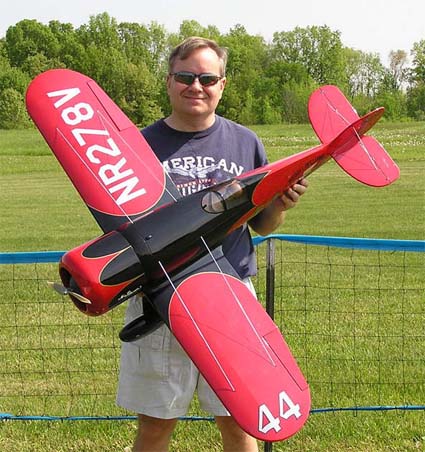
Jim Young flew his Wadell-Williams #44. It is a great looking and flying plane.
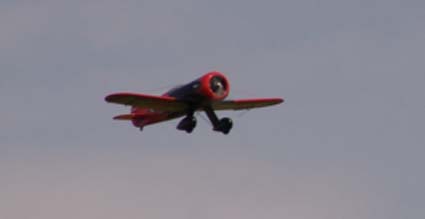
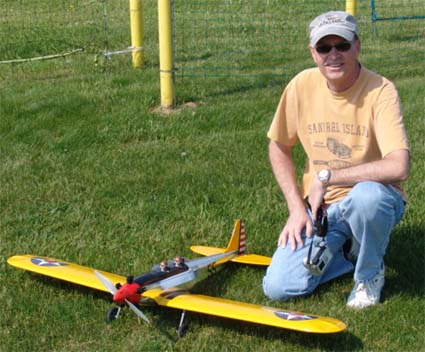
Denny Sumner maidened his beautiful Ryan's Daughter. It flies great! Nice job Denny.
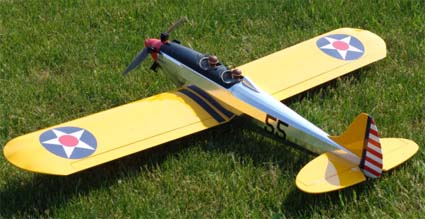
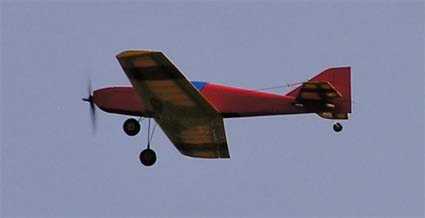
Ken Myers' Fusion 380 was captured in the air by Denny.
There was only one "incident" that marred the great day. Danton Berube's Aerobird Swift bit the dust. It went down while making a straight and level pass parallel to the flight line. A post mortem showed that the elevator servo quit working. I mention this only because this is the second Aerobird Swift to go down at our field due to a faulty elevator servo. I was flying the other one last fall.
Return to "What's In This Issue"
| 








